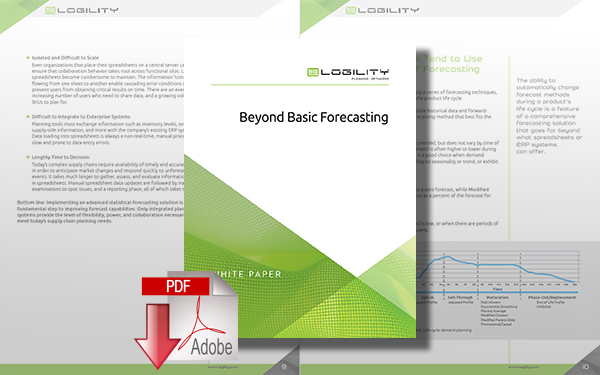Five Tips for Improving Demand Planner Effectiveness

A forecast is more than a projection of future business; it is a request for product (or a request for resources to ensure supply of a product). Forecast accuracy is crucial for achieving both customer service goals as well as ensuring proper utilization of resources to drive profitable business growth.
Given the critical role of the forecast it amazes that today supply chain organizations still routinely rank inaccurate forecasts as a major obstacle in meeting their supply chain goals.
Obtaining a consistently good forecast accuracy continues to be a never-ending struggle that requires skills in math, logic, communication, collaboration and knowledge of the products, customers, markets and industries for which you create the forecasts.
It doesn’t help that finding and retaining qualified planning talent increases the pressure on existing team members as open positions go unfilled.
This post provides five tips for improving a demand planner’s ability to develop more accurate forecasts.
Tip #1 – Deploy a Position Rotation Program
To be truly effective demand planners need to understand how to minimize forecast error and how their forecasts are used. Ask yourself, “is the overall objective to create the most accurate forecasts or is it to create forecasts that minimize costs and maximize company revenue and profit?”
Gaining hands-on experience in using forecasts to purchase product and plan inventory, production and distribution will provide demand planners a unique understanding of how to make their forecasts more useful.
Tip #2 - Certification / System Training
There is a high correlation between skill certification and system training and the ability to create accurate forecasts. Many variables come into play that affect the ability to create accurate forecasts. Some of these variables are uncontrollable others are partially controlled. Demand planner training is one of the few variables you can control.
Tip #3 – Switch to Using Order Data
Using quantity shipped per period can significantly reduce forecast accuracy because this data may not accurately reflect actual customer needs/demand.
Shipment data often encompasses misleading information due to inventory shortages, distribution mistakes and delays, non-repeating calendar effects and other variables that negatively effect On-Time Perfect Order performance. If these non-repeatable errors and events are part of the data used to generate forecasts, your accuracy will be impacted.

Tip #4 – The Importance of Data Scrubbing
Forecasts are only as good as the data used to generate them. Even if you use actual demand history there will be outlying data due to non-repeatable promotions, competitor actions, unplanned events, weather effects, social media impacts, etc. that needs to be addressed to create a ‘corrected’ historical file.
Many demand planning processes do not build enough time in to the periodic schedule to adequately scrub, or correct, the data used to create forecasts. Forecast accuracy can be significantly improved by allowing a bit more time up front to correct the historical data. Advanced planning systems can automatically filter outlying data points, but it is better to do this prior to forecast creation.
Tip #5 – Use Multivariate Pareto (ABC) Analysis
Pareto analysis, also known as ABC classification, is a useful method for classifying forecasted items according to their relative importance to the company.
For example, if the Pareto Analysis is by volume then items that represent 80% of total volume are categorized as type ‘A’, items representing the next 15% of total volume are categorized as type ‘B’ and slower-moving items representing the last 5% of total volume are categorized as type ‘C’.
A rich forecasted item profile can be developed by creating a Pareto segmentation on multiple additional variables such as revenue, profit, production resource, geographic region, business segment, etc.
This profile allows a demand planner to analyze forecast accuracy from a number of different ways to help focus their time and efforts on improving the forecasts of items that will make the biggest impact.
Better forecasting is one of the few ‘power-ups’ available that can drive both top line revenue and bottom line profitability. Creating accurate and useful forecasts requires a blending of art and science and a demand planner’s effectiveness depends heavily on a well thought out process, their access to advanced technology and their level of experience and training.
What do you think? What actions is your company taking to improve its ability to predict demand?
Beyond Basic Forecasting
Of all factors that affect business success over the long term, most executives agree that generating accurate forecasts is right at the top of the list.
 Forecasting has a powerful impact on an organization’s ability to satisfy customers and manage resources cost effectively.
Forecasting has a powerful impact on an organization’s ability to satisfy customers and manage resources cost effectively.
Download Now: Beyond Basic Forecasting
Article Topics
Logility News & Resources
Logility makes entrance into supply chain-focused AI, with acquisition of Garvis Logility Acquires Generative AI Supply Chain Planning Firm Garvis Supply chain software platforms help to level the playing field Logility to acquire supply chain network optimization vendor Starboard Solutions Logility partners with Körber to expand capabilities How Does IKEA’s Inventory Management Supply Chain Strategy Really Work? This is Not Your Father’s Inventory Optimization More LogilityLatest in Supply Chain
U.S. Manufacturing is Growing but Employment Not Keeping Pace The Two Most Important Factors in Last-Mile Delivery Most Companies Unprepared For Supply Chain Emergency Microsoft Unveils New AI Innovations For Warehouses Let’s Spend Five Minutes Talking About ... Malaysia Baltimore Bridge Collapse: Impact on Freight Navigating TIm Cook Says Apple Plans to Increase Investments in Vietnam More Supply Chain













